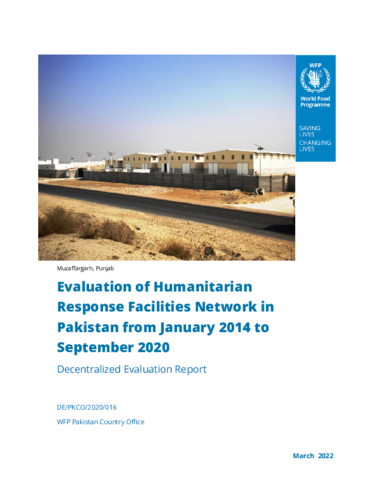
The above evaluation was commissioned by the WFP Pakistan Country Office in 2021.
The overall objectives of Learning and Accountability, the purpose of this decentralized evaluation was to:
- Measure WFP’s contribution to emergency preparedness and response in Pakistan through the HRF network and provide accountability for results as a capacity development partner to the Government of Pakistan
- Identify key enabling factors for capacity development initiatives.
- Provide evaluation evidence, learning and recommendations to guide WFP’s programming and to support the uptake of HRFs within existing disaster management systems
- Provide a more comprehensive understanding of how the HRF network has been integrated into the local government system.
The evaluation covers the period from January 2014 to September 2020. It covers the technical assistance to the Government of Pakistan in the form of HRFs and associated support for effective supply chain management and commodities handling, in the provinces and regions of Pakistan where the intervention took place.
Key findings
- Finding 1. The HRF project is aligned with the GoP’s priorities and the sustainable development goals, and aims to fulfil critical emergency response capacity needs in relation to pre-positioning and storage, operational capacity, and institutional capacity of the government. The HRFs were relevant to, and utilized for, relief operations for several emergencies, including Pakistan’s response to COVID-19 pandemic.
- Finding 2. The HRF project’s focus on strengthening the GoP’s capacity was aligned with the shift in WFP’s strategic engagement towards building community resilience and strengthening institutional capacity. In designing the project, WFP coordinated with relevant government actors, but placed less emphasis on engaging other humanitarian actors in the country.
- Finding 3. The HRF project has been relevant to the general needs of affected populations. However, its design did not incorporate considerations related to gender equality and the empowerment of women (GEEW), prevention of sexual exploitation, the centrality of protection, accountability to affected populations, or the needs of persons with disabilities (M/F).
- Finding 4. The HRF project improved the timeliness and effectiveness of P/SDMA disaster response, albeit with variations by province, through its contributions to increased P/SDMA capacity in supply chain management and through strengthened warehousing and stockpiling systems for critical emergency relief items and search and rescue equipment.
- Finding 5. Through the HRF project, WFP has pursued policies, institutional accountability, strategic planning and financing as pathways for country capacity strengthening. However, there is a need for strengthening the country's capacities in programme M&E and strengthening the participation of communities, civil society and the private sector.
- Finding 6. The HRFs have supported PDMAs’ ability to reach affected populations (M/F) following emergencies in a timely manner. However, PDMAs are not yet in a position to have the required reach to meet the needs of the affected population (M/F) in all areas.
- Finding 7. The COVID-19 pandemic presented opportunities to demonstrate the effectiveness of the HRFs in enhancing PDMA’s capacity to respond to different types of emergencies, including health emergencies.
- Finding 8. The HRF project did not address gender, protection or other cross-cutting dimensions, and this challenged WFP’s ability to achieve cross-cutting aims via the project. There have been recent efforts in some provinces to establish Gender and Child Cells, and to dedicate staffing with specialized expertise in gender and protection.
- Finding 9. The majority of HRFs were constructed and handed over to the GoP within their intended timeframes. Available evidence indicates that WFP’s activities in the delivery of the HRFs were cost-efficient overall, though the utilization of the cold storage space was not optimal in HRFs visited.
- Finding 10. Persistent limitations in communication, coordination and knowledge-sharing within and between the provinces constitute challenges for coherent supply chain management.
- Finding 11. The HRFs have reportedly improved PDMA’s supply chain management capacities to varying extents across all HRFs, with an expansion of HRFs at the divisional and district level.
- Finding 12. The HRF project involved some partnerships and coordination, mainly with government actors (e.g. ministry and departments).
- Finding 13. The HRF project has fulfilled a basic need for improved capacities in sustainable disaster preparedness. However, further support and investment are required to ensure further strengthening of technical and managerial capacities for emergency preparedness and response.
- Finding 14. While some provinces have dedicated financial resources to the HRFs from their budgets, these resources have been insufficient for the maintenance of the HRFs. Challenges in the timeliness of disbursement of funds may in turn limit the timeliness of emergency response.-
Recommendations
- WFP Pakistan should provide overall system support in the area of disaster risk reduction and transition from direct construction.
- The WFP CO should contribute to further enhancing Government of Pakistan coordination frameworks and mechanisms for emergency preparedness and response.
- The WFP CO should prioritize Gender Equality and Empowerment of Women (EEW), protection, and accountability to affected populations (AAP) more systematically in interventions related to emergency preparedness and response.
- WFP should make the case for the Government of Pakistan to consider providing further capacity strengthening in HRF operations and maintenance, and emergency preparedness and response.
